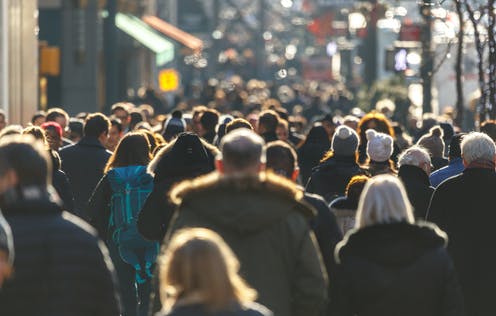blvdone/Shutterstock
Basic models for COVID-19 suggest herd immunity is achieved when 60% of people are immune. This is because in a population where everyone is susceptible to the coronavirus, an infected person is estimated to infect on average an additional 2.5 people. Yet if 60% of those theoretical 2.5 people are immune, then only one new infection can take place, and the outbreak cannot grow.
This is based on a very simple model, though. It assumes that everyone in the population mixes to the same degree and at random. It’s unrealistic. In our research, we tried to reflect some of the diversity of behaviour found in human populations to show what effect it might have on reaching herd immunity.
We looked at two factors that influence the degree to which people mix with each other. The first was sociability.
Those who are more socially active are more likely to be infected in the early stages of an epidemic. This means that over time, naturally acquired immunity tends to be concentrated in those who make lots of social connections, while susceptibility to the disease – and the capability of spreading it – tends to be over-represented among people who make fewer connections.
As we demonstrated, this can affect when the herd immunity threshold is reached. We created an illustrative model in which 25% of people socialise half as much as the average, 50% socialise an average amount, and the remaining 25% socialise twice as much as average. When you have these different groups mixing at these different rates, the model predicts that the herd immunity threshold will be considerably lower: 46.3% instead of 60%.
If more differences between people are considered, the point at which herd immunity is reached through natural infection decreases even further. With this in mind, we considered the effect of age on social mixing.
People in one age group don’t mix equally with people across other age groups; across a population, socialisation follows certain trends. To roughly model this, we split the population into six age groups, and then estimated the amount of contact between them using data from a previous study on social contacts.
We found that accounting for age-specific mixing trends, together different sociability levels, lowered the herd immunity threshold a little further, to 43%.
What does this mean?
The first important thing to say is that our estimates should be interpreted only as a demonstration of how differences in behaviour can affect herd immunity. These figures aren’t exact values, or even best estimates. The activity levels and contact rates between age groups that we used in the model were simply illustrative.
The second thing to note is that we’ve only accounted for two types of variation across the population. More realistic models would be more complex, including many other factors. For example, large household sizes, school and work environments, and metropolitan living all create higher rates of person-to-person contact. In such places a greater proportion of people will get infected, and infection and immunity will be more concentrated among highly active and connected individuals.
Finally, for our model we’ve assumed that immunity doesn’t decrease over time and that it offers 100% protection. Neither of these things are necessarily true.
But what our work does seem to suggest is that most forms of variation across a population will decrease the point at which herd immunity is reached through natural infection. This means that it could be reached at a lower human cost than previously expected. In countries or areas that have already been heavily hit by the virus, herd immunity might already be close. In such places, stopping the spread of the disease might therefore only require getting people to adhere to relatively mild restrictions on social behaviour.
Some words of warning are needed though. Even if the threshold is lower, reaching herd immunity through natural infection will still require a lot of people to get infected. Though lower than initially thought, the human cost would still be very high. The city of Manaus in Brazil may be the first in the world to have reached herd immunity, but one in every 350 people infected with the virus there has died, amounting to around 2,500 deaths in total.
Finally, while variation across the population generally decreases the overall level of immunity needed, among the most active people, the fraction that needs to be infected to reach herd immunity will be more than 60%.
![]()
Pieter Trapman receives funding from Vetenskapsrådet (the Swedish Research Cuncil) grant no 2016-04566.











